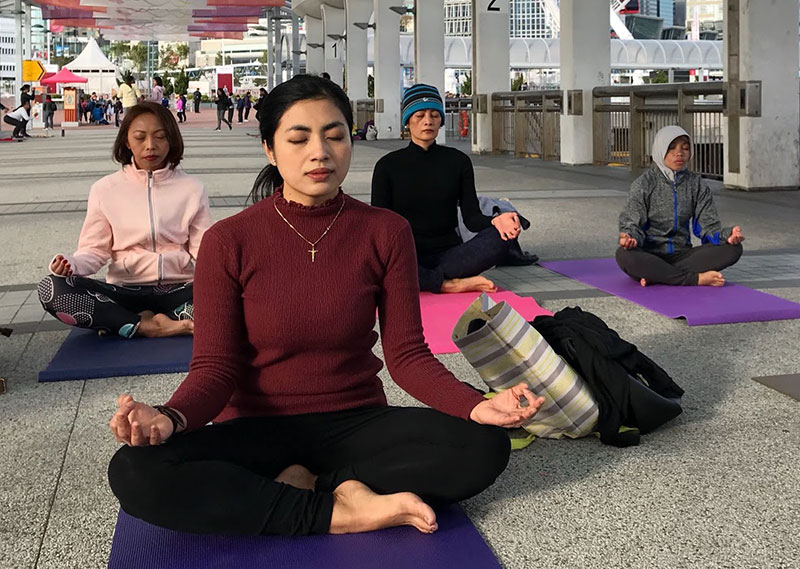Maybe you are a cancer survivor or have a loved one who is. Chances are that someone you know will be affected by cancer during your lifetime.
The International Agency for Research on Cancer (IARC) estimates 21.7 million new cancer cases and 13 million cancer deaths by 2030 (https://www.cancer.org/research/ cancer-facts-statistics/global.html). That means there will be 8.7 million cancer survivors in the next dozen years or so.
After receiving the news of a diagnosis—or, in the best case scenarios, cure, remission, or watchful waiting— these poor souls leave the exam room, schedule a followup appointment and are told to go on with their lives. But how can they when the simplest daily tasks can be a struggle because of worry?
It’s not easy, and I’ve been there. In 2011, newly diagnosed with a rare and aggressive blood cancer, I really wanted to live. I was only thirty-nine with a one-year-old son. In six-months, I quit my job, left my yoga classes to another teacher, put my house on the market, and flew across the United States to the world-renowned City of Hope for chemotherapy and radiation treatments which then led to a life-saving stem-cell transplant.
Though there may be ready access to medical and nutritional information, much of the damage cancer does isn’t physical. That’s where yogic wisdom—specifically working with the breath—comes in.
Cancer and anxiety go hand in hand. It makes sense for cancer survivors to worry.
As worry and stress pile up, the mind can only take so much before tripping the fear switch. We all know that fear triggers the fight-or-flight response in the sympathetic nervous system. Nerve cells fire and chemicals including stress hormones release into the bloodstream.

The best way to counteract too much of those stress hormones is by engaging the parasympathetic nervous system. When we “rest and digest,” our heart rate decreases, bronchial tubes in the lungs and pupils constrict, muscles relax and digestion and gland activity increase. Basically, we chillax.
A great way to chill out and relax is to slow down the breath. In March 2017, researchers at Stanford University in the United States published an article stating (doi: 10.1126/science.aai7984) that they’d discovered the link between slow breathing and calmness in 175 key neurons that connect the “breathing pacemaker” and the arousal center of the brain in mice. Our brains also have breathing and arousal centers, so the researchers hope this newly discovered pathway in mice also exists in human brains.
Yogis and yoginis have practiced breathing techniques for thousands of years.
The practice is called pranayama, from the Sanskrit words prana, meaning “life force,” and ayama, translated as “to extend or draw out.” Put together, they mean breath extension or control. Often yoga teachers use the shorthand “breath work.”
Breathing is one of those automatic functions that our amazing bodies do for us without any thought or consideration. While it’s automatic, we are also able to hold it, lengthen it, and otherwise manipulate the breath as well. This duality is kind of magical. Back in elementary school, I dabbled in the magic of breath manipulation whenever I would compete in “who-can hold- their-breath-longest?” contests in the playground. Though I’d like to lay claim to the discovery of breath manipulation during my seven-year-old antics, I must bow to my pranayama predecessors.

For cancer survivors, pranayama is a way to work with the breath to feel more relaxed during stressful situations. For instance, when the doctor’s office number flashes on cell phone suddenly, or the moment the nurse slides into the clinic room wielding the biggest needle ever, or if the doctor wants to run a few more tests. It may be instinct to curl up into the fetal position. If you were in their shoes, wouldn’t you?
Try breathing like a baby instead.
When we came into this world, we knew how to breathe for our bodies. Just watch a sleeping baby sometime to recognize how each inhale first expands the belly then the rest of the torso. Each exhale releases the air from the collarbones all the way back down to the belly.
The more we leave behind childish games, the more we seem to forget how to breathe well. By the time we’re adults, the natural connection of mind and body fades into the background, and breathing can become an unconscious reflex. We barely sip the air we breathe.
“Baby Belly Breathing” will bring you back to the way you used to breathe, and the way you need to breathe to feel your best, it will decrease your (anxiety in those) moments that catch you off-guard.
Remember, it’s not enough to just survive life. We all, especially cancer survivors, deserve to thrive.
Namasté.


















 Other
Other